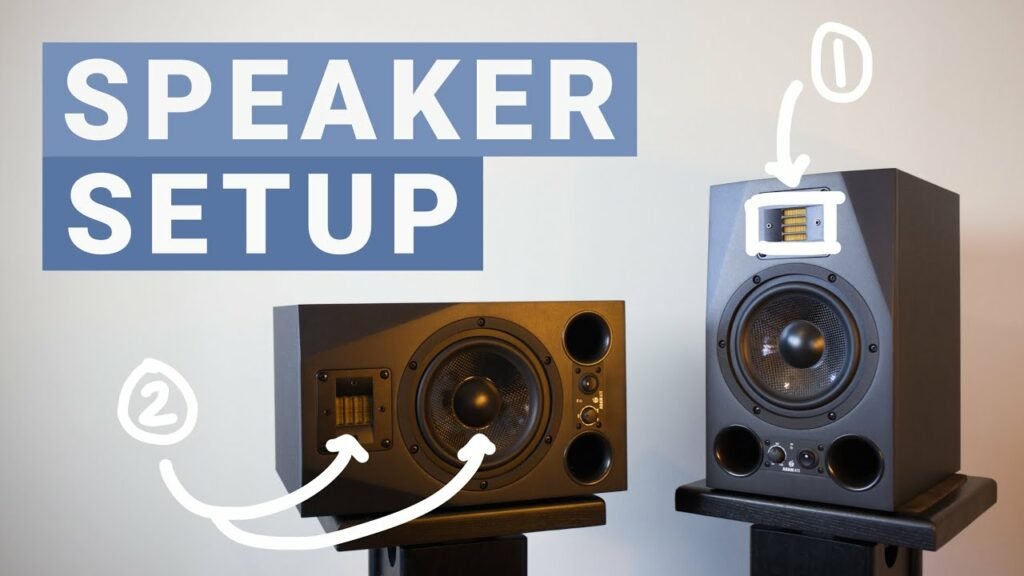
i want to talk about studio setup and in particular loudspeakers or studio monitors whether you should be mounting them vertically or horizontally so upright or on their sides i get this question quite a lot and instead of saying one is wrong or the other is right or criticizing anyone's studio setup i thought i'd just share three factors or considerations that you should take into account when trying to get the most accurate results out of your monitors so let's get right into it the three factors we're going to take into consideration are the shape of the waveguide around the tweeter which will change in every pair of loudspeakers
the second is the phase relationship of the woofer and the tweeter whether you're using a two-way system or a three-way system and the third thing we're going to take into consideration is actually your space limitation the height of your stands whether you're working on a console or a desk that sort of thing and when i talk about all of these this is assuming you want the most accurate results possible because at the end of the day if you bought your speakers you can set them up however you like especially if you're just listening for fun and you're not necessarily wanting the most critical or accurate response so let's first start by looking at the shape of the wave guide so on the tweeter of your speakers which will be reproducing the sound usually above 1k the tweeter might be made of a soft dome material like this or a ribbon and it will have a waveguide around it either built into the case or a special piece of material put there and this is all about dispersion you can see that the waveguide is trying to disperse or spread
those frequencies left and right in the room and the result of this is that when you set up your speakers you toe them in a little bit to make that sort of nice triangle it means that while you have one listening spot in the middle if you move your head side to side maybe you know you're you move up the midi keyboard you reach over to plug in a microphone or you're on a mixing desk the sound stage still stays quite true it doesn't collapse you can still hear a lot of detail and this is good because it means you don't need to stay stuck rigid in your one listening position you can have a little bit of flexibility and things still sound good but you can see from the shape of this waveguide it doesn't really disperse up and down very much if i were to take these same monitors and turn them on their side i'd have to first raise them up to try and get the tweeters at ear level because that's usually a good idea it usually sounds better like that but now you'll see that the waveguides are now dispersing the sound down to the floor and up to the ceiling which isn't very useful because it means you have to tow your speakers in quite a lot and you end up with just one listening position any movement side to side will just collapse the sound stage and it's not going to sound as accurate but it might still sound fun and it might still sound creative but if we want an accurate sound stage it really means that you're limited to one listening position however this is just the wave guide on this one pair of monitors so look at yours see which way it's trying to spread or disperse those frequencies and then you can adjust accordingly if yours is a circle and it's completely symmetrical it might have a very wide dispersion and you might actually be able to get away with putting them on their sides and it might sound great so that's the first factor and it really is just the shape of that waveguide that really lets you know whether you can even turn them on their side at all the second factor to consider is the phase relationship or time alignment of the woofer and the tweeter so you can either have a two-way system or a three-way system but we're just going to look at the the two-way systems at the moment this is where you know you've got the woofer handling everything below about a thousand hertz
and you've got the tweeter handling everything above so just a quick audio example of that this would be the full song [Music] these would be the frequencies the woofer is taking care of and this would be what the tweeter is reproducing [Music] when designing high quality loudspeakers a lot of care has to be put into those crossovers but also keeping both of those in time because when you split the spectrum send some of it to the base woofer split it again send it to the tweeter you have to make sure that they both actually end up leaving that enclosure at the same time because all the sound frequencies will travel at the same speed as long as they're in the same medium which is air here so it's not like the tweeter travels faster and the woofer travels slower or anything like that they both leave the speaker at the same time so when you have speakers set up in a vertical configuration you can see that the distance from the tweeter to my ear and the woofer to my ear is almost exactly the same and this means that we're giving the sound the best chance possible of arriving at my ear in phase now it's never going to be perfect rooms will introduce all sorts of issues to this as well but roughly it's going to be arriving in phase which is going to give us a more accurate sound stage and and it's also going to help avoid any like little nulls and peaks in the spectrum but again your room is going to play an even bigger factor in that now if i was to take the same speakers and rotate them to turn them onto their sides either with the tweeters facing inwards or on the outside and even if i raise them up to my ear height you'll see that the distance now between the tweeter and my ear and the woofer in my ear is different this means that the sound coming from the tweeter and the woofer is not going to arrive at my ear at the same time you'll never perceive this as an audible delay or if you do you have some superhuman hearing but it's enough of a delay to give a phase issue that you will hear as some sort of smearing or skewing of the frequency spectrum or it will introduce some dips and peaks that weren't there before and it should be enough to just throw off the sound
balance but it might sound really cool you know it might actually give you a different bass response that you like the sound of but for the sake of accuracy it's really no good you can sort out some of these issues by further toeing in or turning in the speakers towards your listening position and that will try to get them closer to the same distance from your ears but this might compromise that listening triangle you had set up and it might again further limit your wide sort of listening spot you might not be able to move side to side front to back the same way and there are of course speakers which are designed to be placed on their sides or in this horizontal configuration and these ones usually come with a lot of like an instruction
manual or some documentation which shows you exactly how to turn the speakers in to avoid these sorts of phase issues the third and final consideration is quite an obvious one but it's your space your studio so some people have monitor stands that are permanently set high or they're lucky enough to be working on a console where the bridge of that console is actually quite high just to make space for all those faders and those vu meters there and this means that if you were to place your regular vertical loudspeakers on top the tweeters could be almost a foot above your ears and generally you know we know that you want the tweeters to be somewhere around your ear height just because they tend to sound better there if the tweeters are firing right over your head or they're down and they're firing into your chest things are just gonna sound a little bit mushy a little bit muddy and generally they'll lack distinction so in these situations you'll often see professionals turning their monitors on their side on top of a bridge or on top of high stands because it actually helps get the tweeter at ear level and it's a much better compromise than having the tweeters just firing over the top of their head however there's another way to get around this and that is that if your stands are only a little bit too high or the console bridges is a bit high you can also turn your speakers and tilt them slightly downwards but you have to be careful because when you do this too much it sort of looks like the speakers are just going to fall onto your desk so you know don't don't tilt them too much but a few degrees it might help turn that tweeter down towards your ears and it might be sort of the best of both i don't want to make this video longer than it needs to be other than to say just do
experiment with stuff in your space because i see a lot of um not just beginners but just a lot of people are afraid of you know trying different things you know turn your monitor speakers on their side don't be afraid to you know close in that triangle or make it a bit wider and just see what works for you um things that have worked for me consistently over the years is putting the monitors on stands i've always just found that whether i'm using special isolation or not the monitors to me always sound better on stands even if you can get the cheapest pair of second-hand used stands you can get your hands on i find that getting them off the desk and onto stands just makes them sound so much better so anyway that's pretty much my thoughts on this whole topic and it's a video that i can send anyone's way whenever they ask me this in the future so thank you very much for watching hope you enjoyed it and i'll see you in the next one bye for now [Music]





